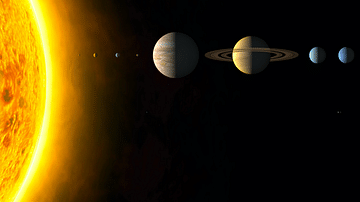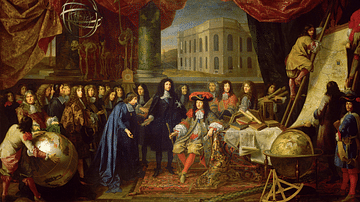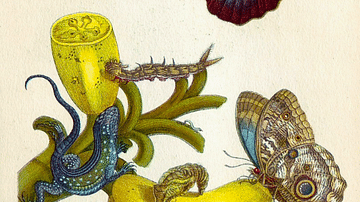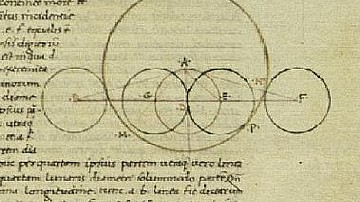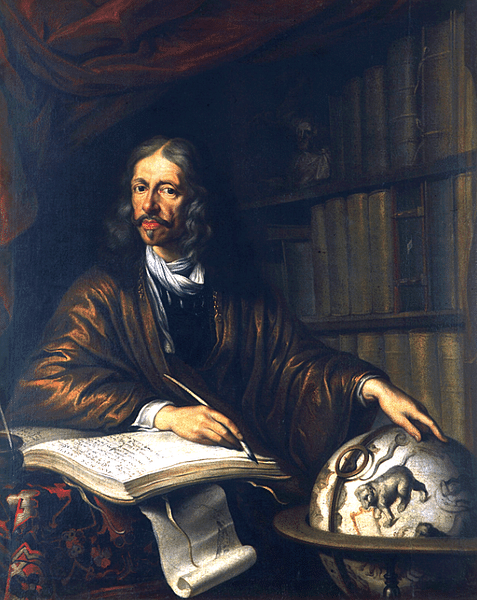
Johannes Hevelius (1611-1687) was a Polish astronomer based in Danzig (Gdańsk). He worked from his own privately funded observatory, creating maps of the Moon's surface, discovering the first variable star, and spotting several new comets. His Prodromus Astronomiae, published posthumously and including many of his own engravings, was the most comprehensive and accurate catalogue of the stars yet compiled.
Early Life
Johannes Hevel, known as Hevelius (or Heweliusz or Howelcke), was born in Danzig (modern Gdańsk) in Poland on 28 January 1611. His was a successful merchant and brewing family, Danzig being one of the four main ports of the Hanseatic League. Johannes was able to study law at the University of Leiden from 1630, although he never took a degree. He also visited France and England in his youth. By 1634, he was back in Danzig, a city from which he only very rarely removed himself for the rest of his life.
Hevelius married, but his first wife died young. He then married again, this time to Catherina Elisabeth (1647-1693). Catherina Elisabeth, a daughter of another successful Danzig merchant, was just 16, and Hevelius was 51 when they married. Hevelius' young wife became his assistant in astronomy from 1662.
Stellaeburg
In 1641, Hevelius established his observatory in Danzig and funded the project himself, which meant he was that rare bird, a 17th-century astronomer independent of rulers and governments. Hevelius was so good at astronomy, though, that he easily attracted investment from several Polish kings and even Louis XIV of France (r. 1643-1715). Louis' finance minister, Jean-Baptiste Colbert (1619-1683), was a keen supporter of science, and he gave Hevelius a sum of money to establish his observatory; the catch was data had to be provided to the French state, which was eager to improve its navigational charts used by the French navy. Later, three of Hevelius' books were dedicated either to Louis XIV or Colbert, but Hevelius remained an independent operator. When not gazing at the stars, Hevelius participated in the local government in Danzig, being both a city councillor and a consul.

Hevelius called his observatory Stellaeburg, and it became such a local talking point that, in 1660, it was visited by King John II of Poland (r. 1648-1668). Hevelius made several important discoveries here in a long career. He had several assistants over the years, most notably his second wife, but also such talented names as Gottfried Kirsch (1639-1710), who was Hevelius' apprentice but then went on to become the most respected astronomer in Germany.
From his observatory, Hevelius observed the first variable star – a star that varies in brightness over time – and named it Mira. He observed the still unfamiliar phenomena of sunspots. Hevelius was the first to spot four comets (1652, 1661, 1672, and 1677). He observed rare transits such as Venus and Mercury moving across the Sun. Most importantly, perhaps, the Moon's surface was systematically observed and mapped over a period of four years. Hevelius' detailed map was a great improvement on arguably the previous best, that drawn some decades before by Galileo Galilei (1564-1642). Hevelius also discovered that the Moon oscillates, a phenomenon which he termed "libration". These observations were made using a purpose-built telescope that Hevelius had made himself, including the specially ground lenses. Hevelius' giant telescope, made in 1647, measured 46 metres (150 ft) in length.
Hevelius' work was particularly useful and particularly impressive to the wider public because, unlike many other scientists, he did not rely on artists and engravers to capture what he had himself seen with his instruments. Hevelius was a gifted and precise artist, and he was able to engrave his own copper plates from which were made his engraved illustrations. This was a crucial advantage, as here explained by the historian A. van Helden:
Hevelius thus produced a seamless path by which information went from his keen eye through his mind, equipped with excellent imagination and memory, to his skilled hand and from there directly to the eye of the reader, without the intervention of anyone else whose interpretation or error might cast doubt on the reliability of the picture. It was as though the reader…was observing the heavens through Hevelius' eye…The method of presenting observations to the public was the best that could be hoped for before photography. (18)
In 1664, Hevelius had the distinction of being one of the first foreign fellows of the Royal Society in London. Hevelius was also a regular contributor to the society's unofficial magazine, Philosophical Transactions. Hevelius was, therefore, an important member of the international network of leading astronomers across Europe who corresponded regularly with each other, sent each other data, and published their work across international borders. For example, when a key but rare event, such as the movement of a planet across the face of the Sun occurred, astronomers like Hevelius compared their readings of the same phenomenon with other astronomers in very different locations so as to maximise the accuracy of the astronomical data recorded.

Visit by Halley
Curiously, the astronomer, while happy to use telescopes for mapping purposes and general observation, did not use them to measure the precise movement of stars and planets over time. Hevelius was also reluctant to incorporate new technological developments into his telescopes, chiefly telescopic sights using an eyepiece micrometer, which helped measure very small changes of position of the heavenly bodies. While such sights and telescopes had strong advocates like Robert Hooke (1635-1703) in England, Hevelius still relied upon his tried and tested instruments for these kinds of observations: his naked eye, a giant sextant, a giant quadrant, and two pendulum clocks. Hevelius had designed and made all of these instruments himself. He claimed he could distinguish a moving body down to five seconds of arc, something an astronomer like Hooke found unbelievable. Indeed, an unsavoury spat broke out between Hooke and Hevelius over the use or non-use of telescopic sights.
In 1679, the English astronomer Edmond Halley (1656-1742) visited Stellaeburg and swapped notes with Hevelius. Halley had been sent there unofficially by the Royal Society of London to find out just how accurate Hevelius' non-telescope readings were. Halley, like Hooke, no doubt had low expectations. The society had also sent Halley to Danzig to try and persuade Hevelius to start using the latest instruments. Halley must have been pleasantly surprised then to find out that when comparing with his own telescope readings taken at Stellaeburg, he realised Hevelius' readings, using his sextant, quadrant, and clocks, were all remarkably accurate. Interestingly, then, "Hevelius' astronomical work was a kind of yardstick by which other European astronomers measured their own accuracy" (Jardine, 30). In addition, "Hevelius' instruments were considered by many to be the best in Europe, and his sharpsightedness, skill, and patience as an observer were celebrated" (van Helden, 18). Not for nothing was Hevelius known as the "Prussian Lynx" (Vertesi, 213).
Halley's visit included a curious incident. Given money to spend on some books that Hevelius ordered, Halley spent the cash on a sumptuous silk dress for Hevelius' wife. The dress cost more than the money Halley had been given by his fellow astronomer, and so he wrote to Catherina Elisabeth asking for the outstanding amount. Revealing his rather dubious motivation behind all this, Halley told Catherina Elisabeth that if she sent Halley a copy of her husband's book on the Moon and another of his latest work on comets, he would consider the 'debt' settled.
Alas, just two months after Halley's visit, on 26 September 1679, a blaze destroyed Stellaeburg, including Hevelius' home and all of his scientific instruments. The fire was perhaps started by a disgruntled servant. Hevelius described the disaster in his appropriately titled Annus climactericus (1685), but he rebuilt what he could and recommenced his astronomy as soon as he had manufactured for himself some new equipment.
Published Works
Hevelius recorded his astronomical findings in beautifully illustrated folios, which included not only images he had drawn of the heavens but also detailed descriptions and pictures of his many astronomical instruments. Hevelius' most famous works are Selenographia (1647) – which contained his celebrated map of the Moon – and Cometographia (1668). Other works include Prodromus cometicus (1665), Machina coelestis (two parts: 1673 & 1679), which describes in detail the astronomer's instruments, and Firmamentum Sobiescianum (1690), which examines seven newly discovered constellations. His great work, which took him over 25 years to compile and which he was never quite finished with, was Prodromus Astronomiae, a comprehensive catalogue and celestial atlas of over 1,564 stars. This catalogue was finally published in 1690 by his wife, three years after his death. It contains, once again, many illustrations that Hevelius drew, and most were made using copper plates that he himself had engraved.
Johannes Hevelius died on his birthday, on 28 January 1687, in Danzig. In truth, his stellar reputation had declined in later years as bigger, better, and more precise telescopes proved that the more traditional instruments he had favoured had outlived their usefulness. Hevelius, though, had been a pioneer in his day, and he remains one of the key figures of astronomy during the Scientific Revolution. Some of Hevelius' names for features of the Moon remain in use today, such as "the Alps" for a certain mountain range. In addition, a crater on the Moon was named after the astronomer, as was a Polish astronomical satellite sent into orbit in 2014.


